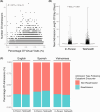Associations between language, telehealth, and clinical outcomes in patients with cancer during the COVID-19 pandemic
- PMID: 39312904
- PMCID: PMC11419674
- DOI: 10.1002/cam4.70099
Associations between language, telehealth, and clinical outcomes in patients with cancer during the COVID-19 pandemic
Abstract
Background: The COVID-19 pandemic prompted a surge in telehealth utilization. However, language barriers have emerged as a potential obstacle to effective telemedicine engagement, impacting millions of limited English proficient (LEP) individuals. Understanding the role of language spoken in telehealth outcomes is critical, particularly in cancer care, in which consistent follow-up and communication are vital. The primary objective was to assess the impact of telehealth utilization and primary language spoken on clinical outcomes in cancer patients.
Methods: This study utilized a retrospective cohort design, encompassing cancer patients seen at the Chao Family Comprehensive Cancer Center between March 1, 2020, and December 31, 2022. The study incorporated both in-person and telehealth visits, examining the association between encounter type and clinical outcomes.
Results: The study included 7890 patients with more than one outpatient visit during the study period. There was decreased telehealth utilization in non-English speaking cancer patients throughout the pandemic. Increased telehealth utilization was associated with higher rates of admission, irrespective of cancer type. Additionally, telehealth visits were associated with longer duration of subsequent admissions compared to in-person visits. Spanish-speaking patients utilizing telehealth had higher rates of re-admission compared to English speakers utilizing telehealth. Patients who died had higher rates of telehealth utilization compared to patients who survived.
Conclusions and relevance: This study demonstrates that primary language spoken is associated with differences in telehealth utilization and associated outcomes in cancer patients. These differences suggest that the interplay of telehealth and language could contribute to widening of disparities in clinical outcomes in these populations. The study underscores the need to optimize telehealth usage and minimize its limitations to enhance the quality of cancer care in a telehealth-driven era.
Keywords: COVID‐19; cancer; health disparities; language barrier; telehealth.
© 2024 The Author(s). Cancer Medicine published by John Wiley & Sons Ltd.
Conflict of interest statement
No authors declare no conflicts of interest.
Figures



Similar articles
-
Health Care Usage During the COVID-19 Pandemic and the Adoption of Telemedicine: Retrospective Study of Chronic Disease Cohorts.J Med Internet Res. 2024 Oct 3;26:e54991. doi: 10.2196/54991. J Med Internet Res. 2024. PMID: 39361360 Free PMC article.
-
Impact of the COVID-19 Pandemic on Health Care Utilization in a Large Integrated Health Care System: Retrospective Cohort Study.J Med Internet Res. 2021 Apr 29;23(4):e26558. doi: 10.2196/26558. J Med Internet Res. 2021. PMID: 33882020 Free PMC article.
-
Barriers and facilitators to pediatric telehealth use in English- and Spanish-speaking families: A qualitative study.J Telemed Telecare. 2024 Apr;30(3):527-537. doi: 10.1177/1357633X211070725. Epub 2022 Jan 24. J Telemed Telecare. 2024. PMID: 35072550
-
Telehealth Utilization in Neuro-Oncology: Commentary on a Single Institution Experience After the COVID-19 Pandemic.Curr Oncol Rep. 2024 Nov;26(11):1271-1276. doi: 10.1007/s11912-024-01588-5. Epub 2024 Jul 31. Curr Oncol Rep. 2024. PMID: 39083169 Review.
-
Telemedicine and Its Perceptions in a Border Community: A Review of How Health Care Technology Has Helped Increase Access.Telemed J E Health. 2024 Apr;30(4):987-993. doi: 10.1089/tmj.2023.0179. Epub 2023 Nov 17. Telemed J E Health. 2024. PMID: 37976130 Review.
References
-
- Mechanic OJ, Persaud Y, Kimball AB. Telehealth Systems. StatPearls; 2024. Accessed July 3, 2024 http://www.ncbi.nlm.nih.gov/books/NBK459384/ - PubMed
MeSH terms
LinkOut - more resources
Full Text Sources
Medical
Miscellaneous

